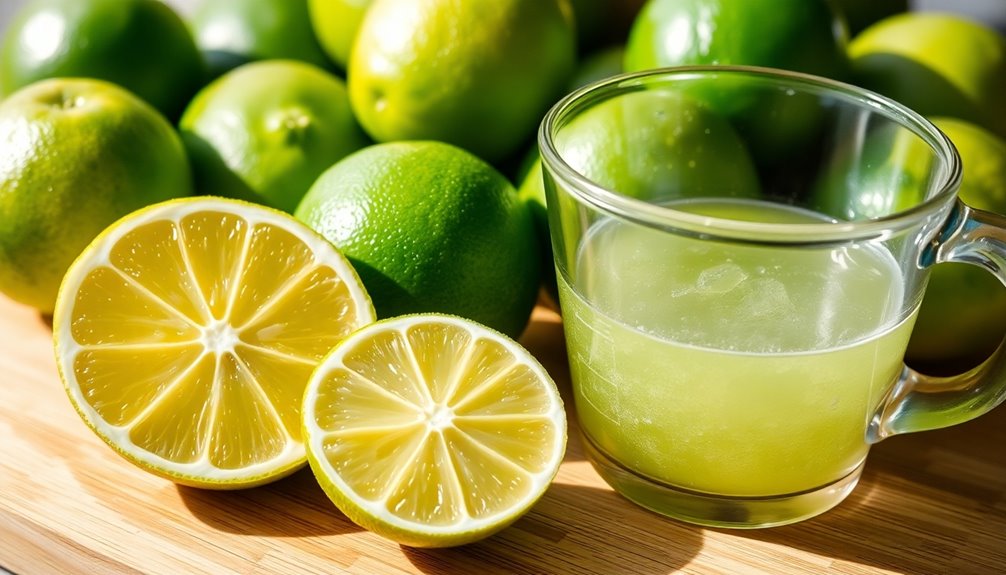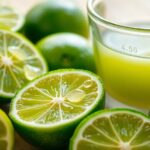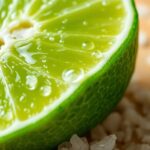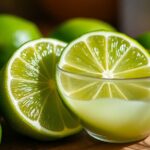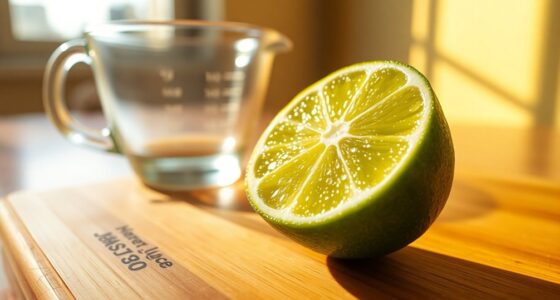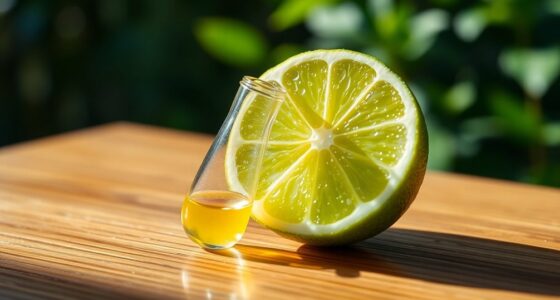To make a full cup of fresh lime juice, you'll need about 8 medium-sized limes. Each lime typically yields around 2 tablespoons, so having a few extra limes on hand is a good idea just in case. If you're using key limes, remember that they're smaller and yield less juice, so you'll need more of them. Want to know how to maximize every drop of juice or other tips? Let's dive deeper into lime juicing!
Key Takeaways
- A full cup of fresh lime juice requires about 8 medium-sized limes.
- Each medium-sized lime yields approximately 1 ounce of juice.
- Key limes are smaller and may require more than 8 to reach a cup.
- 4 medium limes typically yield around 1/2 cup of juice.
- Always keep extra limes on hand to ensure adequate juice yield.
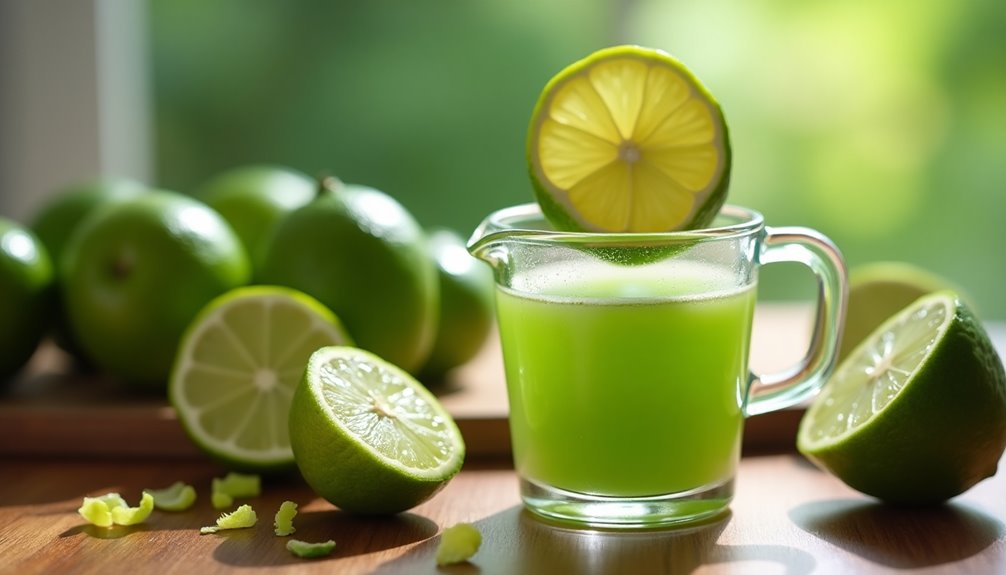
When you're in the kitchen and need a cup of lime juice, you might wonder how many limes you'll need. The answer is pretty straightforward but can vary based on the size and juiciness of the limes you have on hand. Generally, if you're using medium-sized limes, you'll require about eight of them to achieve that full cup of fresh lime juice. Each lime typically yields around 1 ounce of juice, which is equivalent to 2 tablespoons. That means if you're measuring your juice carefully, you can expect each lime to give you a good amount for your recipes.
Now, if you're considering using key limes, keep in mind that they tend to be smaller and may yield a bit less juice than the medium-sized limes. You might need to squeeze quite a few more key limes to reach your desired cup of lime juice. If you're aiming for a specific flavor profile in your dishes, using fresh lime juice is always the best choice. Bottled lime juice can't quite match the vibrant taste of freshly squeezed juice, which can make a big difference in your recipes.
If you're working with a pound of limes, you can expect to find about 4 to 5 limes in there. This amount will usually yield approximately 1/2 to 2/3 cup of juice. So, if you need a full cup, you'll want to have a few extra limes on standby just in case they don't yield as much juice as you'd hoped. Planning ahead is key when you're preparing a dish that calls for lime juice, especially if it's a centerpiece of the flavor.
Let's break it down further: If you know that 4 limes yield about 1/2 cup, it's easy to calculate that you'll need about 8 limes to get a full cup. This can be really helpful when you're shopping or preparing for a gathering. Simply grab a few extra limes to ensure you won't be left short-handed.
When squeezing limes for fresh lime juice, make sure you're using a good juicer or a manual press. This will help extract as much juice as possible, allowing you to get the most out of each lime. You might also want to roll the limes on the counter before cutting them—this can help break down the membranes inside and release even more juice.
Frequently Asked Questions
How Many Limes Do I Need for 1 Cup of Juice?
When you're preparing a recipe that calls for lime juice, knowing how many limes to use is key.
Typically, you'll need about 8 medium limes for a cup of juice, since each yields around 2 tablespoons.
If your limes are smaller, grab 10 to 12 to ensure you have enough.
This way, you won't find yourself short when it's time to mix up that delicious dish or refreshing drink!
Can I Substitute Bottled Lime Juice for Fresh Lime Juice?
Yes, you can substitute bottled lime juice for fresh lime juice, but keep in mind that the flavor won't be the same.
Fresh lime juice has a vibrant taste that enhances dishes like guacamole and cocktails, while bottled juice may contain preservatives that alter its profile.
If you do substitute, use about 1 tablespoon of bottled juice for every tablespoon of fresh, and consider choosing organic brands for better flavor.
How Many Key Limes Make a Cup of Juice?
Picture yourself zesting those tiny, vibrant key limes, their bright green skin releasing a tangy aroma.
You're likely gonna need around 20 of them to fill a cup with juice. Each little fruit yields just 1 to 2 tablespoons, so it takes a handful to get that rich, zesty flavor you crave.
If you're in a pinch, mix Persian limes and lemons for a similar zing without squeezing so many key limes!
Can I Use Regular Limes in Place of Key Limes?
You can use regular limes in place of key limes, but keep in mind that the flavor will differ.
Regular limes are less acidic and have a milder taste, which mightn't replicate the unique qualities of key limes.
If you're making something like key lime pie, consider using a mix of lime and lemon juice to get closer to that distinct flavor.
Adjust the quantity, as you'll need less of the substitute.
Conclusion
So, there you have it! If you ever find yourself in a lime juice dilemma, just remember: it takes about 8 to 10 limes to fill that glorious cup. Imagine squeezing those little green wonders, unleashing a tidal wave of zesty goodness! You're not just making juice; you're creating a citrus symphony! So the next time you whip up a refreshing drink or marinade, go ahead and squeeze like there's no tomorrow—your taste buds will thank you!
Cindy thoroughly researches juicing trends, techniques, and recipes to provide readers with practical advice and inspiration. Her writing style is accessible, engaging, and designed to make complex concepts easy to understand. Cindy’s dedication to promoting the advantages of juicing shines through her work, empowering readers to make positive changes in their lives through the simple act of juicing.

